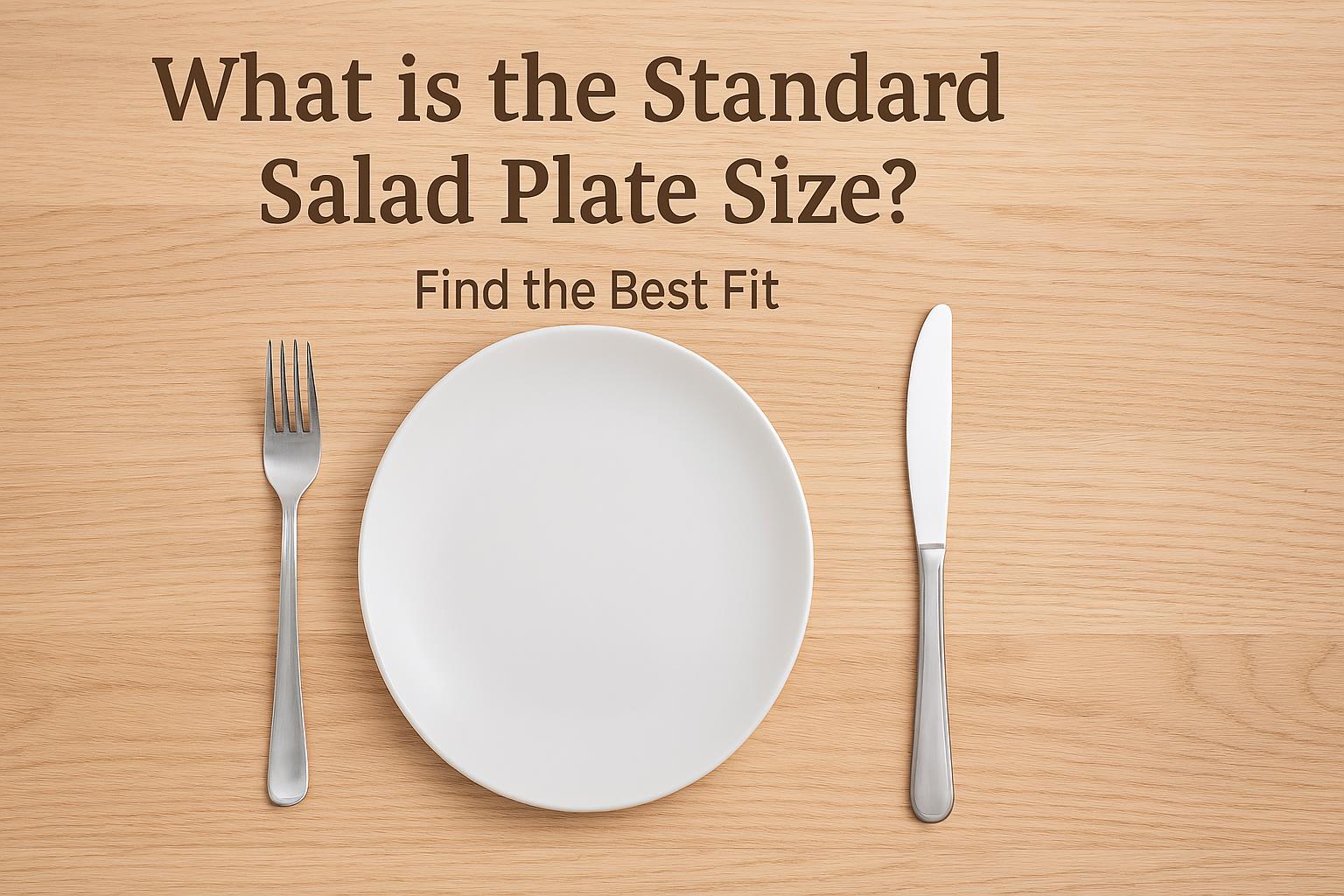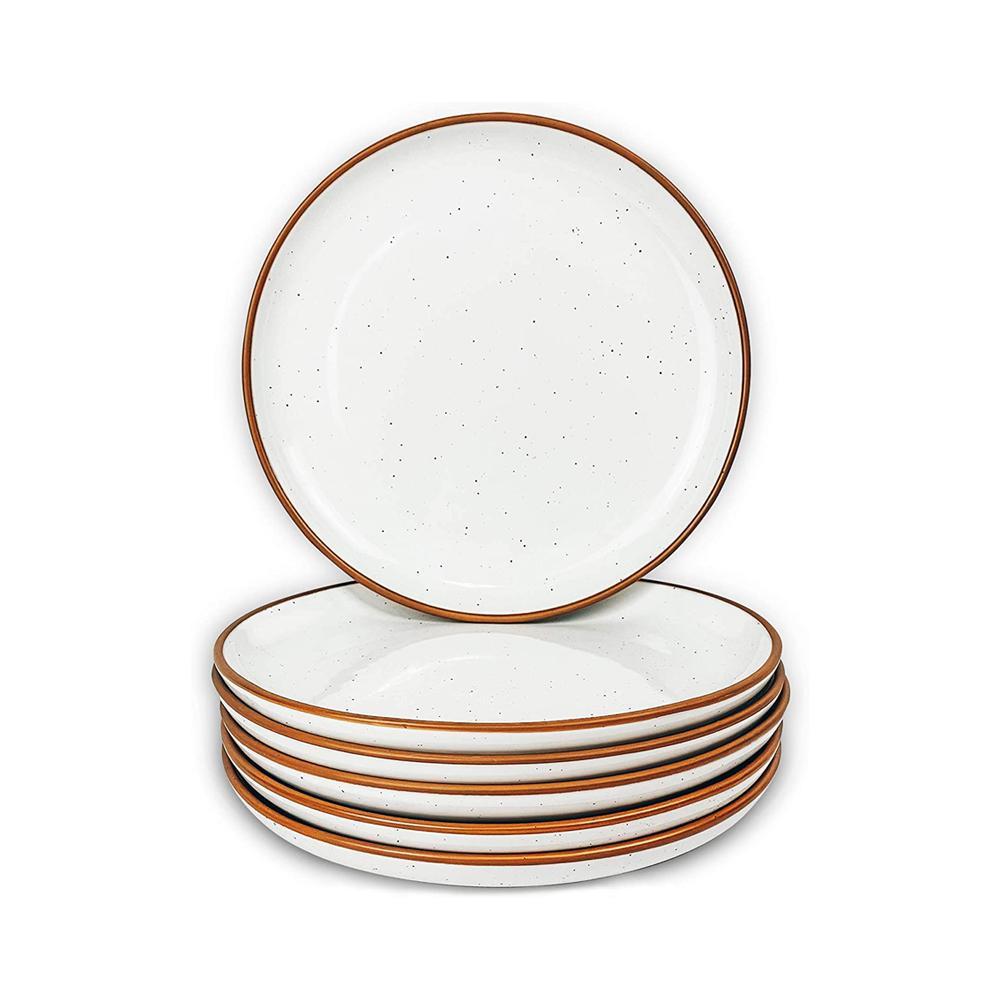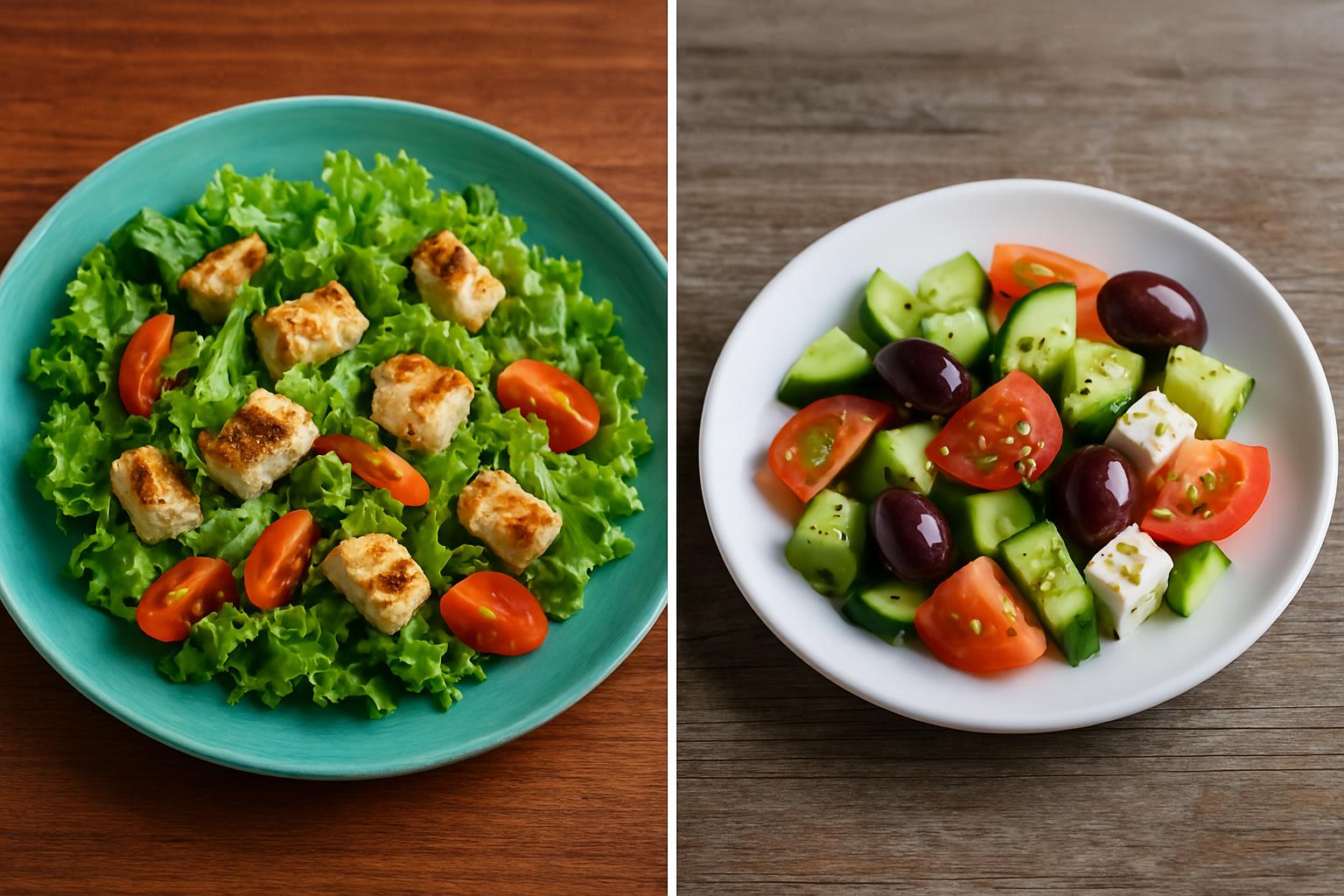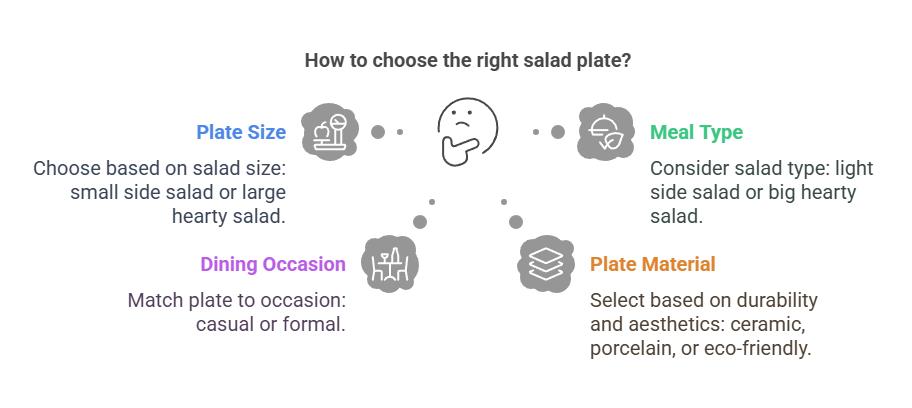What Is The Standard Salad Plate Size? Find The Best Fit
Time of issue: 2025-04-18 10:08:36- What is the Standard Salad Plate Size?
- The Evolution of Salad Plate Sizes
- Regional Influence in Salad Plate Sizes
- Psychology Behind Plate Size and Portion Control
- How To Choose the Right Salad Plate for Your Needs
- How Salad Plate Sizes Impacts Food Presentation
- Wrapping Up
- Frequently Asked Questions (FAQs)

Usually, salad plate sizes range from 7 to 9 inches. Salad plates play a significant role in meals' aesthetics and feels. It also affects how much you can eat. If you're serving a light side salad, a 7-inch plate is a great choice, offering enough space without overwhelming the dish. For heartier main-course salads, a 9-inch plate gives plenty of room. It has enough space to arrange proteins, greens, and toppings in a way that looks appealing.
When picking your salad plate, think about what kind of salad you’re making. Smaller plates are great for side salads. They play a psychological trick of being full without eating more. In comparison, larger plates are better for filling, main-course salads that need more space.
At Global Reach Ceramic, we have a great selection of ceramic plates for any occasion. Whether you’re looking for something simple or a little more decorative, our plates are perfect for your salad. Check out our collection today to find your perfect match!
What is the Standard Salad Plate Size?

The standard size for a salad plate is usually between 7 to 9 inches in diameter. If you're serving a light side salad, a 7-inch plate is just the right size. It’s perfect for a small portion that complements the main dish without being too big. For larger salads that are the main part of the meal, like those with protein or grains, a 9-inch plate gives you more space to spread everything out nicely.
When choosing a plate size, think about what kind of salad you're serving. Smaller plates work well for light, side salads, while bigger plates are better for heartier, meal-sized salads. The right plate size helps make your salad look balanced and more enjoyable to eat!
The Evolution of Salad Plate Sizes

Imagine a time when formal dinners were all the rage, and everything had its place, including the salad plate. Back then, these plates were small, around 7 inches, and used for light, elegant salads that complemented the main course. The smaller size helped with portion control and kept everything looking neat and tidy.
Fast forward to the mid-20th century, and things started to change. With more casual dining becoming the norm, salad plates grew bigger. By the 1950s and 60s, 9-inch plates were the new standard. Why? Because salads were no longer just a side dish. They were becoming the star of the meal, often packed with proteins like chicken, shrimp, or cheese.
Today, we’re seeing a return to smaller plates. As people focus more on health and mindful eating, 7-inch plates are coming back into style, especially for lighter salads. It’s crazy how something as simple as a plate can reflect the changing times! Whether it’s big or small, it all comes down to what works best for your meal.
Regional Influence in Salad Plate Sizes
Salad plate sizes can actually change based on where you are, and it’s pretty interesting how different regions have their own preferences. In the U.S., you’ll typically find salad plates ranging from 7 to 9 inches, but the size can vary depending on the area. For example, in the South, where meals are often served family-style, larger plates are more common to accommodate bigger portions. These larger plates are ideal for hearty, meal-sized salads.
On the other hand, in Mediterranean countries like Italy or Greece, salad plates are generally smaller, around 7 inches. This fits with their tradition of serving light, fresh salads as a side dish rather than the main event. These salads often feature simple ingredients like olives, tomatoes, and cucumbers.
Whether it’s a large plate for a generous portion or a smaller one for a light side, regional variations in plate sizes reflect different dining customs and culinary traditions!
Psychology Behind Plate Size and Portion Control
The size of your plate isn’t just about how it looks. It actually affects how much you eat. This is where psychology comes into play. When you eat from a smaller plate, your brain tricks you into thinking you’re getting a bigger portion. That’s because the food looks more plentiful on a smaller surface, which can help you feel satisfied with less.
On the other hand, larger plates tend to make us serve ourselves more food, often without realizing it. It’s easy to overload a big plate, and that can lead to overeating. That’s why portion control is easier when you use a smaller plate, like a 7-inch salad plate, especially if you’re trying to eat lighter or maintain healthy eating habits. By simply choosing a smaller plate, you can help manage your portions, feel full, and still enjoy your meal without overdoing it!
How To Choose the Right Salad Plate for Your Needs

Choosing the right salad plate is simple when you keep a few things in mind. Here are the key factors that will help you pick the perfect plate:
Plate Size
The size of your plate is really important. For a small side salad, a 7-inch plate is perfect, and it gives just enough room without being too big. But if you’re serving a bigger salad with more ingredients or proteins, a 9-inch plate gives you enough space to spread everything out nicely.
Meal Type
Think about what kind of salad you're making. If it's a light, side salad, a smaller plate works best. If it's a big, hearty salad with proteins, grains, or toppings, a larger plate is better. A bigger plate helps make sure your salad looks good and everything fits nicely.
Dining Occasion
The occasion can influence your choice of plate. For casual, everyday meals, plates made from melamine or bamboo are great because they’re durable and easy to clean. For more special dinners or formal events, you might want ceramic or porcelain plates, which look fancy and make your meal feel extra special.
Plate Material
The material of your plate matters for both looks and how easy it is to take care of. Ceramic, porcelain, and stoneware are classic choices that are sturdy and look nice. If you want something more modern or eco-friendly, you might choose glass or bamboo plates. Just keep in mind that some materials, like ceramic, can be a little more delicate and require more care.
Design and Style
The design of your plate should match your personal style and the look of your table. Whether you like simple, clean designs or something more colorful, choose a plate that fits the vibe of your meal and your home. The right design can make your meal feel more fun or elegant!
Functionality and Durability
Think about how often you’ll use these plates. If you’re using them every day, you’ll want something that’s durable and can stand up to regular cleaning. If they’re for special occasions, you can focus more on how they look, since you won’t be using them as often.
Ease of Storage
Finally, make sure the plates are easy to store in your kitchen. If you have limited space, look for plates that stack well and don’t take up too much room. Lightweight plates are also easier to handle and store, especially if you need to fit a lot of plates into a small space.
How Salad Plate Sizes Impacts Food Presentation
The size of your salad plate can make a big difference in how your meal looks. The right plate size is all about balance.
When you use a smaller plate, your salad will look fuller, even if it’s a lighter portion. The food fills up the space more, giving the illusion of a bigger serving. This works especially well for side salads, where you want to keep it light but still make it look satisfying.
A larger plate gives your salad room to breathe. It allows the ingredients to spread out, showcasing the different textures and colors. This is perfect for bigger, meal-sized salads, as it helps each ingredient stand out and makes the salad look more balanced.
If the plate is too big, your salad might look lost. If it’s too small, it could look cramped. Picking the right plate ensures your salad looks as good as it tastes!
Wrapping Up
The size of your salad plate plays an important role in both the presentation and enjoyment of your meal. A 7-inch plate is ideal for light side salads, while a 9-inch plate is perfect for larger, meal-sized salads with more ingredients. The right plate size helps with portion control and ensures that your salad looks appetizing and well-balanced.
So, the next time you're serving up a salad, consider the plate size that best suits your meal. For beautiful, high-quality ceramic plates, check out Global Reach Ceramic for all your dining needs.
Frequently Asked Questions (FAQs)
Question: What is the size of the salad plate?
Answer: A salad plate typically ranges from 7 to 9 inches in diameter. The smaller 7-inch plates are great for side salads, while the larger 9-inch plates are used for more substantial, meal-sized salads.
Question: What is an 8.5-inch plate used for?
Answer: An 8.5-inch plate is often used for serving side salads, appetizers, or light meals. It offers enough space for a portion of food without being too large, making it a versatile choice for lighter dishes or as a small main course plate.
Question: What is the difference between a salad plate and a dinner plate?
Answer: A salad plate is typically smaller, around 7 to 9 inches, while a dinner plate is larger, usually 10 to 12 inches. Salad plates are designed to serve lighter dishes like salads, while dinner plates are for main courses and provide more space for multiple food items.
Question: Can I use a dinner plate for salad?
Answer: You can, but a smaller salad plate is usually better suited for salads. Using a dinner plate may make your salad look smaller or less visually appealing due to the extra empty space on the plate.
RECENT POSTS
- The Benefits of Wholesale High-Quality Ceramic Products for Retailers
2025-12-17
- Can You Make an Ashtray with Air Dry Clay? Pros, Cons, and Safer Alternatives
2025-12-17
- The Impact of Ceramic Materials in Energy-Efficient Buildings: Benefits and Applications
2025-12-04
- Top 7 Ceramic Cookware Health Benefits: Why It’s a Safer Choice for Your Kitchen
2025-12-04
- How to Clean Ceramic Planters and Improve Their Lifespan?
2025-11-17
- 15 Best Ceramic Holiday Gift Ideas for 2025: Thoughtful, Elegant & Heartfelt
2025-11-17
- Stoneware vs Porcelain vs Earthenware: Quick Decision Guide
2025-10-09
- Are Ceramic Glazes Food Safe? The Truth Behind the Shine
2025-10-09










